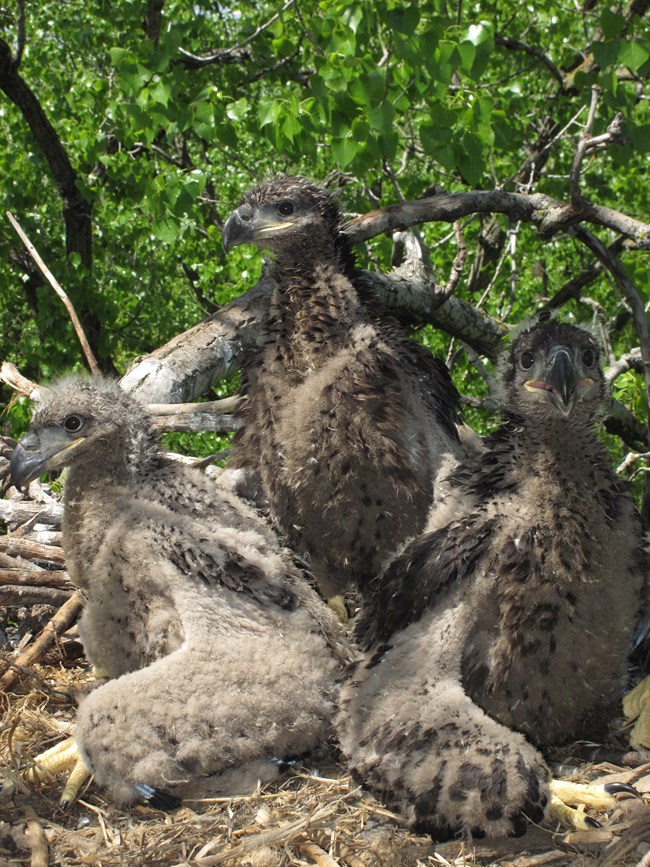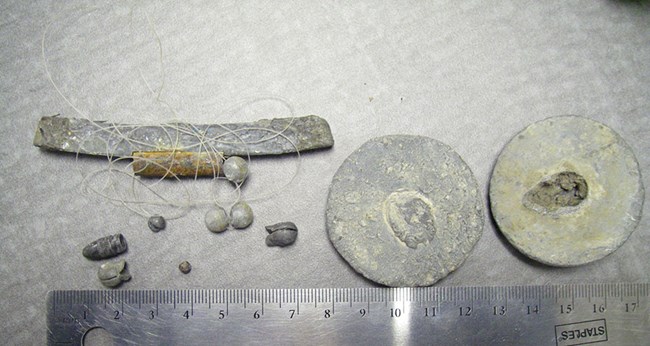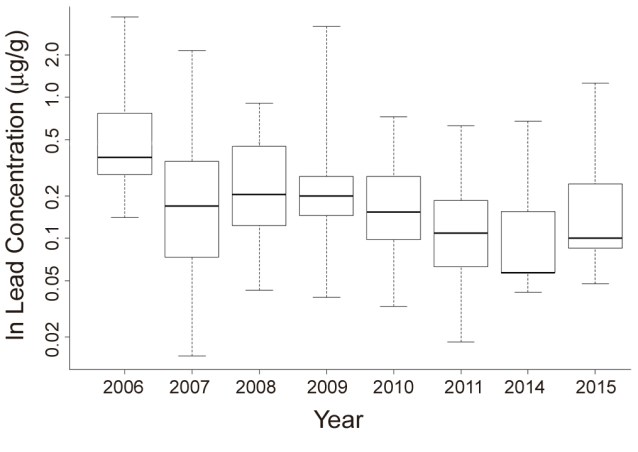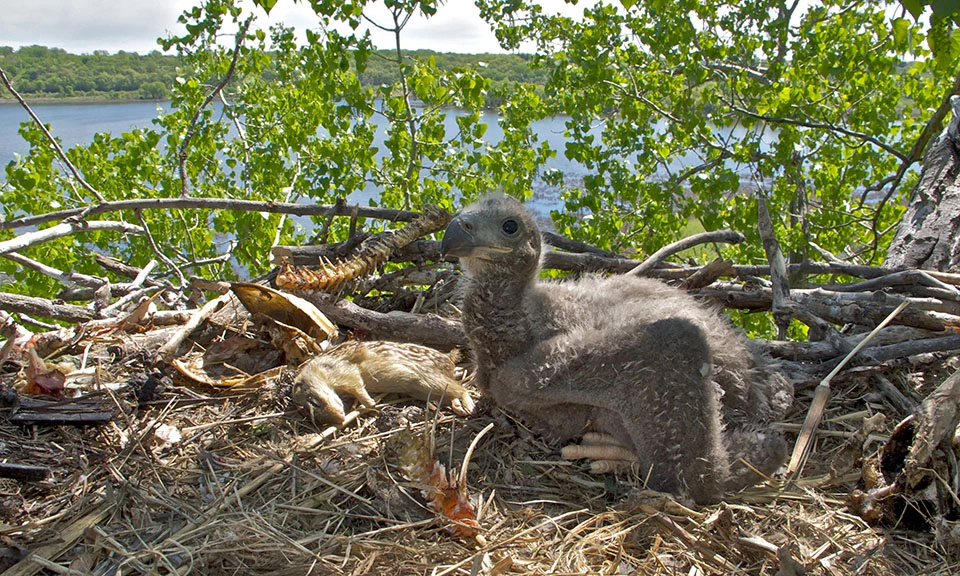Last updated: January 8, 2024
Article
Lead Contamination in Bald Eagle Nestlings

PHOTO ©JIM SPICKLER
Lead (Pb) is a toxic heavy metal used extensively in the early 1900s in products such as gasoline, paint, and pesticides. Its use in the U.S. declined following passage of the Clean Air Act (1970) and subsequent amendments to phase out lead from paint (beginning in 1971) and most gasolines (beginning in 1990). Lead was also banned from use in ammunition for waterfowl hunting (1991). Despite all this, lead is still used in some aviation fuels, ammunition for shooting sports and for hunting upland game (e.g., deer and grouse), fishing tackle, batteries, tire weights, and many other products.
Lead enters the environment directly through lost fishing tackle or chipped paint, and through the breakdown of products in the waste stream. Wildlife and humans that inadvertently consume lead can suffer neurological effects. The Centers for Disease Control and Prevention (CDC) set a threshold of 5 micrograms (μg) of lead per deciliter (dL) of blood as the level above which a human child needs medical attention. Most studies on the toxicological effects of Pb have been done on humans and have shown that even levels <2 μg/dL can cause behavioral problems and adverse health effects in children. One review of Pb toxicology found that humans, birds, and fish process Pb the same as they do calcium, so much of what has been learned about Pb toxicity in humans can be extrapolated to other animals.
Bald eagles (Haliaeetus leucocephalus) are useful sentinels for studying contamination in aquatic systems because they are on top of the food web and fish are their primary prey—a food source they share with humans. From 2006 through 2015, the Great Lakes Inventory and Monitoring Network collected blood and feather samples from bald eagle nestlings at Apostle Islands National Lakeshore (APIS), the Mississippi National River and Recreation Area (MISS), and the St. Croix National Scenic Riverway (SACN) as part of an effort to monitor environmental contaminant levels. We collected 367 feather samples from 2006 through 2015 and 188 whole blood samples from 2010 through 2015.

NPS PHOTO
Straight From the Source
Potential sources of acute Pb exposure include spent ammunition, fishing tackle, and prey that already contain high amounts of Pb in their tissues. However, because we sampled nestlings during the late spring (May and June)—well after the fall deer hunting season—it is unlikely these nestlings ingested lead bullet fragments from deer remains, which is one of the most noted sources of bald eagle lead poisoning.
We think it is likely that bald eagle nestlings are exposed to lead primarily from feeding on fish. Among the prey remains we found in eagle nests, the most common were fish (80% of nests), while birds (30%) and mammals (25%) were found much less often. We also found fishing tackle in 2% of the nests we visited, including fishing line with lead sinkers entangled with fish remains in the nest. However, some of the exposures could have resulted from feeding on squirrels, turkeys, or waterfowl that contain Pb fragments or shot.
What We’re Finding
Our results show that the amount of Pb in feathers is a measure of chronic, or long-term, exposure (accumulating over weeks), while the amount of Pb in blood is a measure of acute exposure resulting from a recent meal.
We found Pb concentrations in feathers and blood from nestlings at MISS to be significantly higher than at other study areas. Levels were also high at Mississippi River Pools 3 & 4 (MP 3&4), followed by the lower St. Croix River (L-SACN), the Lake Superior South Shore (LSSS), APIS, and the upper St. Croix (U-SACN) (Figures 1a and 1b).
The pattern of high concentrations in nestling feathers are geographically clustered (Figure 1a), whereas high concentrations in blood are more dispersed across the study areas (Figure 1b). In particular, bald eagles sampled from nests along the Mississippi River near and immediately downstream from Pig’s Eye Lake had the highest feather-Pb concentrations. By contrast, we found the highest concentrations of blood-Pb in nestlings on the St. Croix River.
Lead levels in nestling breast feathers declined from 2006 through 2015 (Figure 2), but this decline was not evident for Pb levels in blood. The decrease of Pb in feathers coincides with U.S. Environmental Protection Agency (EPA) data showing an 87% decrease in the national average of Pb concentrations in air from 2000 to 2014. The decline of Pb in air is largely attributed to regulations on Pb in vehicle gasoline.



Management Implications
Our results show Pb is declining overall but is still accumulating in the food web, with some chronic localized contamination occurring, especially in the Pig’s Eye Lake area at MISS.
Many eagle territories at MISS are within metropolitan Minneapolis-St. Paul, where they are exposed to effluent from municipal and industrial waste water treatment plants, as well as airborne pollutants from airports, refineries, power plants, and vehicle traffic. Many of these are potential sources of chronic exposure to Pb.
In particular, Pig’s Eye Lake is adjacent to both the outlet of the metropolitan waste water treatment plant and the former Pig’s Eye Landfill, which is a Minnesota Superfund site. The Minnesota Department of Health and Human Services documented elevated levels of Pb in both soils and water from this area prior to the start of contaminants monitoring by the National Park Service. Some of the high levels of Pb we measured in nestling feathers could be from this chronic source.
We know of no studies on the direct effects of Pb on bald eagle nestlings. The University of Minnesota Raptor Center considers adult bald eagles with blood-lead concentrations between 20 and 60 μg/dL as having subclinical exposure (contamination without signs or symptoms) and concentrations between 61 and 120 μg/dL as having clinical poisoning. While no guidelines exist for nestlings, it is noteworthy that one nestling we measured was above the subclinical threshold, with >26 μg/dL of Pb in its blood. Two other nestlings had Pb levels between 16 and 17 μg/dL, which approaches the Raptor Center’s threshold for subclinical levels in adult eagles. Moreover, 12 of the nestlings we sampled exceeded the CDC’s threshold for human children.
The good news is that we found lead levels to be declining overall, and at the population level, we found no evidence of impaired productivity. Nest productivity along the Mississippi River was significantly higher than among nests on the south shore of Lake Superior (LSSS) or the upper St. Croix River (U-SACN), even though nestlings in the Mississippi River nests had some of the highest Pb concentrations in feathers and whole blood.

PHOTO ©JIM SPICKLER
Tags
- apostle islands national lakeshore
- mississippi national river & recreation area
- saint croix national scenic riverway
- glkn
- bald eagle
- contaminants
- inventory and monitoring
- im
- mississippi river
- st. croix river
- lake superior
- apostle islands national lakeshore
- st. croix national scenic riverway
- mississippi national river and recreation area
- great lakes network
